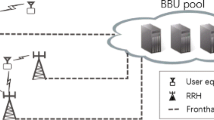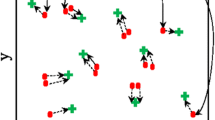Abstract
User-centric and energy efficient are becoming two foremost design principles in the cloud radio access networks (Cloud-RAN). In this paper, we thus consider the problem of how to assign each user to several preferred remote radio heads (RRHs) and design the corresponding beamforming coefficients in a user-centric and energy efficient manner. We formulate this problem as a joint clustering and beamforming optimization problem, with the objective to maximize the energy efficiency (EE) while satisfying the users’ quality of service (QoS) requirement and respecting the RRHs’ transmit power limits. We first transform it into an equivalent parametric subtractive problem using the approach in fractional programming, and then it is cast into a tractable convex optimization problem by introducing a lower bound of the objective function. Finally, the structure of the optimal solution is derived and a two-tier iterative scheme is developed to find the clustering pattern and beamforming coefficients that maximize EE. Specially, we derive a RRH-user association threshold, based on which the RRH clustering pattern and the corresponding beamforming coefficients can be simultaneously determined. Through simulations, we show the superior performance of the proposed user-centric clustering and beamforming scheme in Cloud-RAN.









Similar content being viewed by others
Notes
Here, the “group” refers to the collection of beamforming coefficients associated with each RRH.
References
Fan C, Zhang Y J, Yuan X (2016) Advances and challenges toward a scalable cloud radio access network. IEEE Commun Mag 54(6):29–35
Alexandropoulos G C, Ferrand P, Gorce JM, Papadias C B (2016) Advanced coordinated beamforming for the downlink of future lte cellular networks. IEEE Commun Mag 54(7):54–60
Zhang J, Chen R, Andrews J G, Ghosh A, Heath R W (2009) Networked mimo with clustered linear precoding. IEEE Trans Wirel Commun 8(4):1910–1921
Fan C, Zhang Y J, Yuan X (2016) Advances and challenges toward a scalable cloud radio access network. IEEE Commun Mag 54(6):29–35
Bassoy S, Farooq H, Imran M A, Imran A (2017) Coordinated multi-point clustering: a survey. IEEE Commun Surv Tutor 19(2):743–764
I CL, Rowell C, Han S, Xu Z, Li G, Pan Z (2014) Toward green and soft: a 5g perspective. IEEE Commun Mag 52(2):66–73
Ge X, Yang J, Gharavi H, Sun Y (2017) Energy efficiency challenges of 5g small cell networks. IEEE Commun Mag 55(5):184–191
Huang X, Xue G, Yu R, Leng S (2016) Joint scheduling and beamforming coordination in cloud radio access networks with qos guarantees. IEEE Trans Veh Technol 65(7):5449–5460
Ha V N, Le L B, Dào N D (2014) Energy-efficient coordinated transmission for cloud-rans algorithm design and trade-off. In: 2014 48th Annual conference on information sciences and systems (CISS), pp 1–6
Guruacharya S, Niyato D, Bennis MI, Kim D I (2013) Dynamic coalition formation for network mimo in small cell networks. IEEE Trans Wireless Commun 12(10):5360–5372
Ramamonjison R, Haghnegahdar A, Bhargava V K (2014) Joint optimization of clustering and cooperative beamforming in green cognitive wireless networks. IEEE Trans Wirel Commun 13(2):982–997
Huang J, Zhang T et al (2010) The benefit of group sparsity. Ann Stat 38(4):1978–2004
Dai B, Yu W (2013) Sparse beamforming for limited-backhaul network mimo system via reweighted power minimization. In: 2013 IEEE Global communications conference (GLOBECOM), pp 1962–1967
Zhao J, Quek T Q S, Lei Z (2013) Coordinated multipoint transmission with limited backhaul data transfer. IEEE Trans Wirel Commun 12(6):2762–2775
Zhuang F, Lau V K N (2014) Backhaul limited asymmetric cooperation for mimo cellular networks via semidefinite relaxation. IEEE Trans Signal Process 62(3):684–693
Dai B, Yu W (2014) Sparse beamforming and user-centric clustering for downlink cloud radio access network. IEEE Access 2:1326–1339
Lin J, Li Q, Li Y, Jiang C (2014) Dynamic base station clustering and beamforming for an uplink simo cloud radio access network. In: 2014 IEEE International conference on communiction problem-solving, pp 421–424
Pompili D, Hajisami A, Tran T X (2016) Elastic resource utilization framework for high capacity and energy efficiency in cloud ran. IEEE Commun Mag 54(1):26–32
Tao M, Chen E, Zhou H, Yu W (2016) Content-centric sparse multicast beamforming for cache-enabled cloud ran. IEEE Trans Wirel Commun 15(9):6118–6131
Bin H, Hua C, Zhang J, Chen C, Guan X (2017) Joint fronthaul multicast beamforming and user-centric clustering in downlink c-rans. IEEE Trans Wireless Commun
Jiang C, Cimini L J (2013) Energy-efficient transmission for mimo interference channels. IEEE Trans Wirel Commun 12(6):2988–2999
Jie X, Qiu L (2013) Energy efficiency optimization for mimo broadcast channels. IEEE Trans Wirel Commun 12(2):690–701
Gong S, Xing C, Yang N, Yik-Chung W, Fei Z (2017) Energy efficient transmission in multi-user mimo relay channels with perfect and imperfect channel state information. IEEE Trans Wirel Commun 16(6):3885–3898
Jingya L, Bjornson E, Svensson T, Eriksson T, Debbah M (2015) Joint precoding and load balancing optimization for energy-efficient heterogeneous networks. IEEE Trans Wireless Commun 14(10):5810–5822
Fehske A J, Marsch P, Fettweis G P (2010) Bit per joule efficiency of cooperating base stations in cellular networks. In: 2010 IEEE Globecom workshops, pp 1406–1411
Boyd S, Vandenberghe L (2004) Convex optimization. Cambridge University Press
Shi Q, Razaviyayn M, Luo Z Q, He C (2011) An iteratively weighted mmse approach to distributed sum-utility maximization for a mimo interfering broadcast channel. IEEE Trans Signal Process 59(9):4331–4340
Bertsekas D P (1999) Nonlinear programming. Athena Scientific Belmont
Bach F, Jenatton R, Mairal J, Obozinski G (2012) Optimization with sparsity-inducing penalties. Found Trends Mach Learn 4(1):1–106
Negro F, Ghauri I, Slock D T M (2012) Sum rate maximization in the noisy mimo interfering broadcast channel with partial csit via the expected weighted mse. In: 2012 International symposium on wireless communication systems (ISWCS), 576– 580
Rahman M M U, Ghauch H, Imtiaz S, Gross J (2015) Rrh clustering and transmit precoding for interference-limited 5g cran downlink. In: IEEE Globecom Workshops (GC Wkshps). IEEE, p 1–7
Lo T K Y (1999) Maximum ratio transmission. In: 1999 IEEE International conference on communications, 1999. ICC ’99, vol 2, pp 1310–1314
Ngo H Q, Larsson E G, Marzetta T L (2013) Energy and spectral efficiency of very large multiuser mimo systems. IEEE Trans Commun 61(4):1436–1449
Tseng P (2001) Convergence of a block coordinate descent method for nondifferentiable minimization. J Optim Theory Appl 109(3):475–494
Author information
Authors and Affiliations
Corresponding author
Appendices
Appendix A: Proof of proposition 3
Define indicator function \(I(\mathbf {v}) = \left \{ \begin {array}{llllll} 1\quad , & ~ \text {if } \mathbf {v} \in \mathcal {V}, \\ - \infty , & ~ \text {otherwise}. \end {array} \right .\). Then we can rewrite the problem P2 and P3 as the following unconstrained optimization problem respectively:
We can see that the smooth part of \( \mathcal {F}_{1}(\mathbf {v}), \mathcal {F}_{2}(\mathbf {v}) \) are differentiable, and the indicator function I(v) is separable across variables w,u and v. When other block variables are fixed, an unique optimal solution can be obtained. Combining these properties and applying Theorem 4.1 in [34], we can conclude that the proposed BCD method converges to a stationary solution of problem P3.
Furthermore, if (w∗,u∗,v∗) is the stationary solution of problem (41), then based on Theorem 1, we have
Then using the stationary point definition and Danskin’s Theorem [28], we can obtain the following relationship
where \( (0, \ldots , \mathbf {d}_{\mathbf {v}_{k}}, 0, \ldots , 0) \) is a vector of zero entries except for the block corresponding to the variable v k with value \( \mathbf {d}_{\mathbf {v}_{k}} \), and f′(x∗; d) is defined as the directional derivative of function f(⋅) at point x∗ in the direction d, which can be calculated by \(f^{\prime }(\mathbf {x}^{*}; \mathbf {d}) = \lim \inf _{\lambda \downarrow 0} \left [ f(\mathbf {x}^{*} + \lambda \mathbf {d}) - f(\mathbf {x}^{*}) \right ] /\lambda \). Hence, according to Eq. 43, v∗ is also a stationary point of problem P2.
Appendix B: Proof of proposition 4
Define \(\mathbf {D}_{mk}(c_{mk})\triangleq \frac { \mathbf {A}_{m}+\mathbf {B}_{mk}+ \left (\frac { \alpha _{k} p_{c} \theta c_{mk} }{2}+\theta \xi +\mu _{m} \right ) \mathbf {I}_{N} }{c_{mk}} \) , and rewrite the function as \( \varphi (c_{mk}) = \left \|w_{k} u_{k} \mathbf {D}_{mk}^{-1}(c_{mk}) \mathbf {h}_{mk}\right \|_{2} \)
Since c m k > 0, A m , B m k , D m k (c m k ) and \(\mathbf {h}_{mk}\mathbf {h}_{mk}^{H}\) all are positive semi-definite, we have \( \frac {\partial \varphi (c_{mk}) }{\partial c_{mk}} > 0\). Therefore φ(c m k ) is a strictly increasing function of c m k .
Rights and permissions
About this article
Cite this article
Chen, Y., Lu, Z., Wen, X. et al. User-centric Clustering and Beamforming for Energy Efficiency Optimization in Cloud-RAN. Mobile Netw Appl 23, 503–517 (2018). https://doi.org/10.1007/s11036-018-1014-2
Published:
Issue Date:
DOI: https://doi.org/10.1007/s11036-018-1014-2




